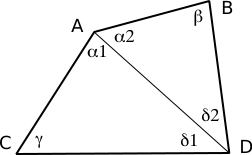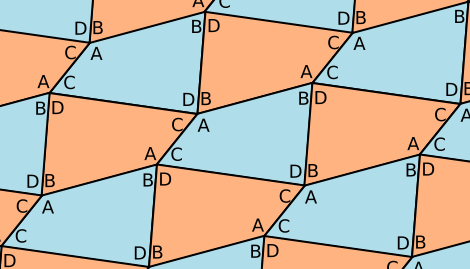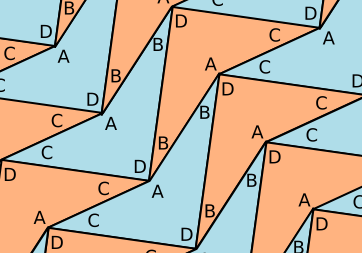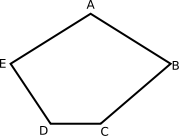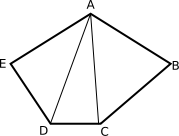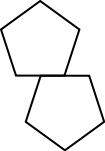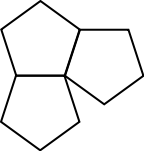Tessellations by Squares, Rectangles and other Polygons
K-12: Materials at high school level.

Some Basic Tessellations
Recall that a polygon is just a simple geometric shape. The polygons we will be talking about are squares, rectangles, parallelograms, the rhombus and maybe a couple of other ones.
If you haven't thought about polygons for a couple of weeks it may be useful to quickly sneek a peek at some of the examples we talked about earlier: Squares, Rectangles, Parallelograms and Other Polygons
In this section we will be looking at the following:
Question: Which polygons tile the plane?
Another way of saying this is: which polygons can be used to tile say a floor or a wall? This means we are looking for shapes that fit together nicely, without any gaps or overlaps to create a pattern. Some people call these patterns tilings, while others call them tessellations. Both words are correct. We may use them both in this text.
The most common and simplest tessellation uses a square. You may not have thought about it, but you will ahve seen titlings by squares before. A lot of bathrooms have square tiles on the floor. A lot of classsrooms will have squares on the floor and there may even be squares in the ceiling.
Squares easily form horizontal strips:
Stacks of these strips cover a rectangular region and the pattern can clearly be extended to cover the entire plane. This easily gives us the result that:
All squares tessellate.
The same technique works with parallelograms. You can put parallelograms side by side and create these strips. If you stack the trips you will have a tiling by parallelograms, and so:
All parallelograms tessellate.
Looking for other tessellating polygons is a complex problem, so we will organize the question by the number of sides in the polygon.
The simplest polygons have three sides, so we begin with triangles:
All triangles tessellate.
To see this, take an arbitrary triangle and rotate it about the midpoint of one of its sides. The resulting parallelogram tessellates:

The picture works because all three corners (A, B, and C) of the triangle come together to make a 180° angle - a straight line. This property of triangles will be the foundation of our study of polygon tessellations, so we state it here:
The sum of angles of any triangle is 180°.
Moving up from triangles, we turn to four sided polygons, the quadrilaterals. Before continuing, try the Quadrilateral Tessellation Exploration.
Tessellations by Quadrilaterals
Recall that a quadrilateral is a polygon with four sides.
The sum of angles in any quadrilateral is 360°
To prove, divide a quadrilateral into two triangles as shown:
Since the angle sum of any triangle is 180°, and there are two triangles, the angle sum of the quadrilateral is 180° + 180° = 360°. Taking a little more care with the argument, we have:
and .
Then
.

The point of all the letters is that the angles of the triangles make the angles of the quadrilateral, which would not work if the quadrilateral was divided as shown on the right.
We now turn to the main result of this section:
All quadrilaterals tessellate.
Begin with an arbitrary quadrilateral ABCD. Rotate by 180° about the midpoint of one of its sides, and then repeat using the midpoints of other sides to build up a tessellation.
The angles around each vertex are exactly the four angles of the original quadrilateral. Since the angle sum of the quadrilateral is 360°, the angles close up, the pattern has no gaps or overlaps, and the quadrilateral tessellates.
Recall from Fundamental Concepts that a convex shape has no dents. All triangles are convex, but there are non-convex quadrilaterals. The technique for tessellating with quadrilaterals works just as well for non-convex quadrilaterals:
It is worth noting that the general quadrilateral tessellation results in a wallpaper pattern with p2 symmetry group.
Tessellations by Convex Polygons
Every shape of triangle can be used to tessellate the plane. Every shape of quadrilateral can be used to tessellate the plane. In both cases, the angle sum of the shape plays a key role. Since triangles have angle sum 180° and quadrilaterals have angle sum 360°, copies of one tile can fill out the 360° surrounding a vertex of the tessellation.
The next simplest shape after the three and four sided polygon is the five sided polygon: the pentagon. The angle sum of any pentagon is 540°, because we can divide the pentagon into three triangles:
Since each triangle has angle sum 180° the angle sum of the pentagon is 180° + 180° + 180° = 540°.
Rather than repeat the angle sum calculation for every possible number of sides, we look for a pattern. The angle sum of a triangle (3-gon) is 180°, the angle sum of a quadrilateral (4-gon) is 2x180°, and the angle sum of a pentagon is 3x180°. A general polygon with sides can be cut into triangles and so we have:
The sum of the angles of an -gon is .
Unlike the triangle and quadrilateral case, the pentagon's angle sum of 540° is not helpful when trying to fit a bunch of pentagons around a vertex. In fact, there are pentagons which do not tessellate the plane.
For example, the regular pentagon has five equal angles summing to 540°, so each angle of the regular pentagon is . Attempting to fit regular polygons together leads to one of the two pictures below:
Both situations have wedge shaped gaps that are too narrow to fit another regular pentagon.
Thus, not every pentagon tessellates. On the other hand, some pentagons do tessellate, for example this
house shaped pentagon:
![]()

The house pentagon has two right angles. Because those two angles sum to 180° they can fit along a line, and the other three angles sum to 360° (= 540° - 180°) and fit around a vertex.
Thus, some pentagons tessellate and some do not. The situation is the same for hexagons, but for polygons with more than six sides there is the following:
No convex polygon with seven or more sides can tessellate.
This remarkable fact is difficult to prove, but just within the scope of this book. However, the proof must wait until we develop a counting formula called the Euler characteristic, which will arise in our chapter on Non-Euclidean Geometry.
Nobody has seriously attempted to classify non-convex polygons which tessellate, because the list is quite likely to be too long and messy to describe by hand. However, there has been quite a lot of work towards classifying convex polygons which tessellate. Because we understand triangles and quadrilaterals, and know that above six sides there is no hope, the classification of convex polygons which tessellate comes down to two questions:
- Which convex pentagons tessellate?
- Which convex hexagons tessellate?
Question 2 was completely answered in 1918 by K. Reinhardt.[1] Reinhardt showed that there are only three types of convex hexagons which tessellate:
Reinhardt also addressed Question 1 and gave five types of pentagon which tessellate. In 1968, R. Kershner[2] found three new types, and claimed a proof that the eight known types were the complete list. A 1975 article by Martin Gardner[3] in Scientific American popularized the topic, and led to a surprising turn of events.
In fact Kershner's "proof" was incorrect. After reading the Scientific American article, a computer scientist, Richard James III, found a ninth type of convex pentagon that tessellates. Not long after that, Marjorie Rice, a San Diego homemaker with only a high school mathematics background, discovered four more types, and then a German mathematics student, Rolf Stein, discovered a fourteenth type in 1985.
In 2015, Casey Mann discovered a 15th type with an extensive computer search. Then, in 2017, Michael Rao ran a computer simulation of all possible ways that pentagons could come together, and finally proved that the 15 types are the only possibilities. The question was unanswered for almost a century, waiting for a solution!
| Sides | Angle Sum | Tessellates? |
|---|---|---|
| 3 | 180° | Yes. All triangles tessellate. |
| 4 | 360° | Yes. All quadrilaterals tessellate. |
| 5 | 540° | Sometimes. There is a list of 15 types of convex pentagons which tessellate. |
| 6 | 720° | Sometimes. There is a list of 3 types of convex hexagons which tessellate. |
| 7 & up | 900°, 1080°, ... | No convex -gon tessellates for |
Tessellations by Regular Polygons
Recall that a regular polygon is a polygon whose sides are all the same length and whose angles all have the same measure. A regular -gon has equal angles that sum to , so:
The corner angle of a regular -gon is .
The table shows the corner angles for the first few regular polygons:
| Number of Sides | 3 | 4 | 5 | 6 | 7 | 8 | 9 | 10 | 11 | 12 |
|---|---|---|---|---|---|---|---|---|---|---|
| Corner angle | 60° | 90° | 108° | 120° | ~128.6° | 135° | 140° | 144° | ~147.3° | 150° |
Regular Tessellations
- Regular tessellation
- A tessellation using one regular polygon tile, arranged so that edges match up.
Corners of the tiles need to fit together around a point, which means the corner angle of the regular polygon must evenly divide 360°. Since
,
there is a regular tessellation using six triangles around each vertex. Since
,
there is a regular tessellation using four squares around each vertex. And since
there is a regular tessellation using three hexagons around each vertex. We have already seen that the regular pentagon does not tessellate. A regular polygon with more than six sides has a corner angle larger than 120° (which is 360°/3) and smaller than 180° (which is 360°/2) so it cannot evenly divide 360°. We conclude:
A major goal of this book is to classify all possible regular tessellations. Apparently, the list of three regular tessellations of the plane is the complete answer. However, these three regular tessellations fit nicely into a much richer picture that only appears later when we study Non-Euclidean Geometry.
Tessellations using different kinds of regular polygon tiles are fascinating, and lend themselves to puzzles, games, and certainly tile flooring. Try the Pattern Block Exploration.
Archimedean tessellations - * Optional
An Archimedean tessellation (also known as a semi-regular tessellation) is a tessellation made from more that one type of regular polygon so that the same polygons surround each vertex.
 |
 |
 |

|
| (3,6,3,6) | (3,4,6,4) | (3,12,12) | (3,3,3,4,4) |
 |
 |
 |

|
| (4,8,8) | (3,3,4,3,4) | (4,6,12) | (3,3,3,3,6) |
We can use some notation to clarify the requirement that the vertex configuration be the same at every vertex. We can list the types of polygons as they come together at the vertex. For instance in the top row we see on the left a semi-regular tessellation with at every vertex a (3,6,3,6) configuration. We see a 3-gon, a 6-gon, a 3-gon and a 6-gon.
The other tessellations on the top row have a (3,4,6,4), a (3,12,12), and a (3,3,3,4,4) configuration. These configurations are unique up to cyclic reordering (and possibly reversing the order). For example (3,12,12) can also be written as (12,12,3) or (12,3,12). In the bottom row we have (4,8,8), (3,3,4,3,4), (4,6,12) and (3,3,3,3,6) configurations.
Recall that creating a tessellation requires the angle sums of the polygons to add up to 360° around a vertex. We know from a previous section that the angle of a regular n-gon is . If we have a collection of n-gons: , then the angles of those polygons need to add up to 360°:
Dividing both sides by 180° gives us the following equation:
.
For example, suppose that , then we have: . This means that 3 triangles and 2 squares will give us a vertex type. In this case we can arrange these polygons around the vertex in two different ways: (3,3,3,4,4) and (3,3,4,3,4). Both of these will give rise to a semi-regular tessellation.
Recall that a semi-regular tessellation satisfies the following requirements:
- All the tiles are regular polygons
- It is a tessellation, hence no gaps or overlaps
- All the vertices are of the same type.
There are only 21 combinations of regular polygons that will fit around a vertex. And of these 21 there are there are only 11 that will actually extend to a tessellation. Below are the different vertex types. An asterisk indicates that this vertex type cannot be extended to a tessellation.
| type | N=3 | N=4 | N=5 | N=6 | N=7 | N=8 | N=9 | N=10 | N=12 | N=15 | N=18 | N=20 | N=24 | N=42 | vertex configuration(s) |
|---|---|---|---|---|---|---|---|---|---|---|---|---|---|---|---|
| 1 | 6 | (3,3,3,3,3,3) | |||||||||||||
| 2 | 4 | 1 | (3,3,3,3,6) | ||||||||||||
| 3 | 3 | 2 | (3,3,3,4,4) | ||||||||||||
| 4 | 3 | 2 | (3,3,4,3,4) | ||||||||||||
| 5 | 2 | 1 | 1 | (3,3,4,12) (*) | |||||||||||
| 6 | 2 | 1 | 1 | (3,4,3,12) (*) | |||||||||||
| 7 | 2 | 2 | (3,3,6,6) (*) | ||||||||||||
| 8 | 2 | 2 | (3,6,3,6) | ||||||||||||
| 9 | 1 | 2 | 1 | (3,4,4,6) (*) | |||||||||||
| 10 | 1 | 2 | 1 | (3,4,6,4) | |||||||||||
| 11 | 1 | 1 | 1 | (3,7,42) (*) | |||||||||||
| 12 | 1 | 1 | 1 | (3,8,24) (*) | |||||||||||
| 13 | 1 | 1 | 1 | (3,9,18) (*) | |||||||||||
| 14 | 1 | 1 | 1 | (3,10,15) (*) | |||||||||||
| 15 | 1 | 2 | (3,12,12) | ||||||||||||
| 16 | 4 | (4,4,4,4) | |||||||||||||
| 17 | 1 | 1 | 1 | (4,5,20) (*) | |||||||||||
| 18 | 1 | 1 | 1 | (4,6,12) | |||||||||||
| 19 | 1 | 2 | (4,8,8) | ||||||||||||
| 20 | 2 | 1 | (5,5,10) (*) | ||||||||||||
| 21 | 3 | (6,6,6) |
From the table we can see that:
Theorem 1: There are 3 regular tessellations of the plane.
Theorem 2: There are 8 semi-regular (Archimedean) tessellations of the plane.
For some more information see Archimedean Exploration
Relevant examples from Escher's work
- Fundamental forms of regular division of the plane, Visions of Symmetry pg. 33
- Sketch #A7 (Regular division with triangles)
- Tessellation by triangles, sketch (2) from the abstract motif notebook, Visions of Symmetry pg. 83.
- Sketch #131-134 (Pentagon tessellations), and Tiled Column, New Lyceum, Baarn
- Tessellation by hexagons, Visions of Symmetry pg. 90
Related Sites
- Java applet for quadrilateral tessellations. By Shodor Interactive.
- Topics in Tiling by Eric Weisstein at Wolfram Research.
Convex Pentagons
- The 14 known types of convex pentagons that tessellate. By http://www.mathpuzzle.com
- A brief history of convex pentagon tessellations. By Doris Schattschneider.
- Intriguing Tessellations. By Marjorie Rice.
- Tessellations by Hexagons. By David King.
Notes
- ↑ K. Reinhardt, Über die Zerlegung der Ebene in Polygone. (Inaugural-Disstertation, Univ. Frankfurt a.M.) R. Noske, Borna and Leipzig, 1918.
- ↑ R. Kershner, On Paving the Plane, The American Mathematical Monthly 75, October 1968, pg. 839-844
- ↑ Martin Gardner, Time Travel and Other Mathematical Bewilderments Ch. 13. W.H. Freeman, 1988
